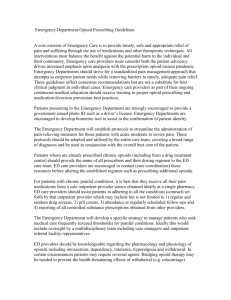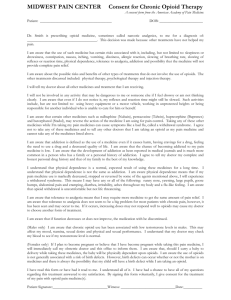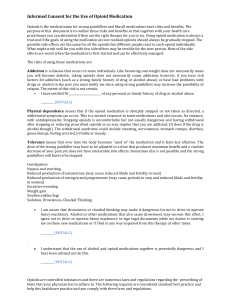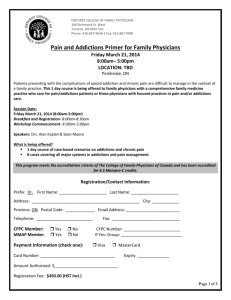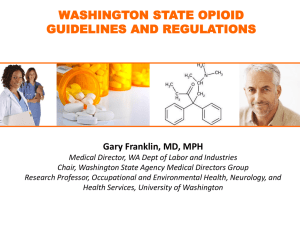Opioids And Persistent Pain
advertisement
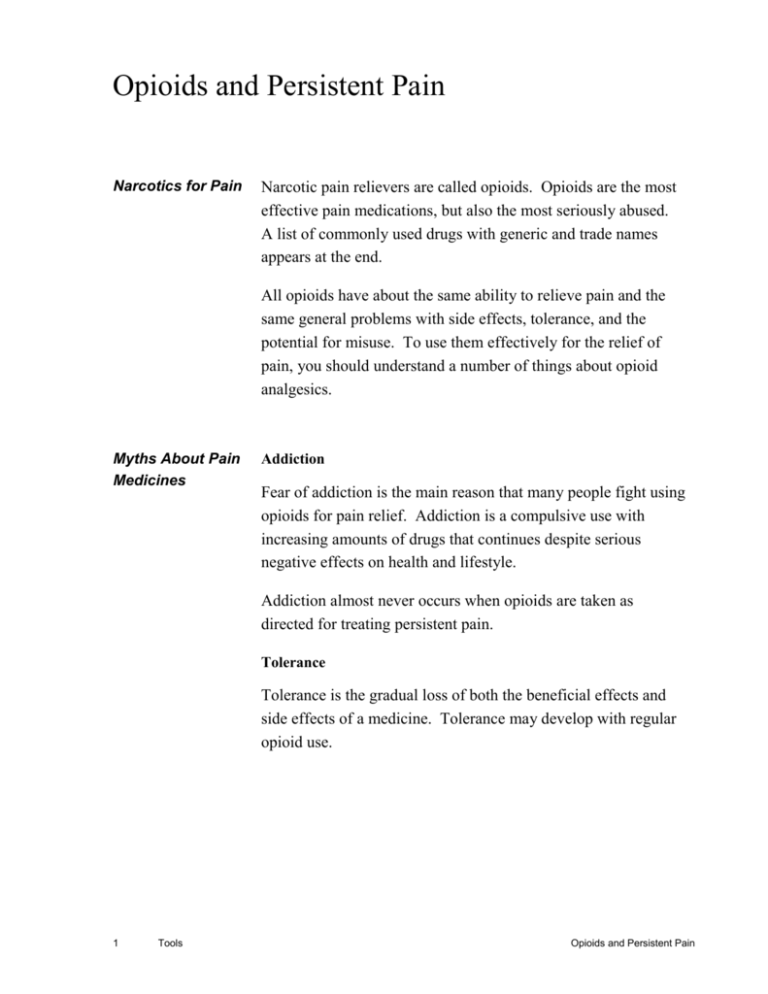
Opioids and Persistent Pain Narcotics for Pain Narcotic pain relievers are called opioids. Opioids are the most effective pain medications, but also the most seriously abused. A list of commonly used drugs with generic and trade names appears at the end. All opioids have about the same ability to relieve pain and the same general problems with side effects, tolerance, and the potential for misuse. To use them effectively for the relief of pain, you should understand a number of things about opioid analgesics. Myths About Pain Medicines Addiction Fear of addiction is the main reason that many people fight using opioids for pain relief. Addiction is a compulsive use with increasing amounts of drugs that continues despite serious negative effects on health and lifestyle. Addiction almost never occurs when opioids are taken as directed for treating persistent pain. Tolerance Tolerance is the gradual loss of both the beneficial effects and side effects of a medicine. Tolerance may develop with regular opioid use. 1 Tools Opioids and Persistent Pain Myths About Pain Medicines, continued Tolerance to side effects, such as the sleepiness produced with initial doses of opioids, is good. Often after a few days of use, the sleepiness you feel goes away and allows you to use even larger doses of opioids for severe pain without excessive sleepiness. Tolerance to the beneficial effects, such as the ability to relieve pain, is a problem. Over time the pain relief from the amount of medicine you started with will gradually lessen, but should never disappear. Tolerance can always be overcome with more medicine. If you have persistent pain, you will need to find a balance between pain relief, costs, and negative effects of larger doses. Tolerance has nothing to do with addiction. If your pain medicine stops working, talk to your doctor. It could be due to a change in your underlying condition. Withdrawal Withdrawal is the development of certain predictable symptoms when the use of opioids is stopped too quickly. Withdrawal symptoms include nausea, sweating, and anxiety. Withdrawal has nothing to do with addiction. You can easily avoid withdrawal by gradually reducing the amount of opioids taken until they can be stopped without symptoms. Positive Changes 2 Tools You take opioids to make your pain better — and to make your life better. For most people, this means resuming activities that were stopped by your pain and illness. Opioids and Persistent Pain Positive Changes, continued Take advantage of the opportunity that pain relief brings to add something positive to your life. If you take opioids to eliminate your pain without improving your life, the pills may become the focus of your life and can do more harm than good. Talk to your family about how much the opioid is helping your mood, function, and attitude. If the opioid is not helping, talk to your doctor. You should not keep taking a drug that is making your life worse. Opioid Types Common opioids can produce long-acting and short-acting results. See the table at the end for a list of short- and longacting opioids. Short-Acting Most opioids in their usual form are short acting. They take effect in a half hour or so and relieve pain for about four hours. Short-acting opioids, which are often combined with an over-thecounter pain reliever like acetaminophen (Tylenol), are good to use before you do something that usually causes pain. Occasional use of short-acting opioids minimizes side effects and is least likely to cause tolerance and withdrawal symptoms. Long-Acting Long-acting opioids are put into a special time-release tablet, capsule, or skin patch. The medicine is released gradually and gives a continuous level of pain control for the effective time specific to the medication. 3 Tools Opioids and Persistent Pain Opioid Types, continued Long-Acting, continued The oral, long-acting versions are usually taken every 8 to 24 hours, and the patch type is designed to last 3 days. Long-acting medicines are used when you need some pain control at all times, or at least for a longer period than the 4 hours of the short-acting type. Long-acting opioids can be combined with short-acting medicines to boost the effectiveness of the pain medicine at specific times of the day, when better pain control can help you function better. Using long-acting opioids continuously will cause some tolerance. Side Effects The side effects of opioids should be anticipated and actively managed. Constipation The most predictable side effect of opioid treatment is constipation. If you plan to take opioids regularly, start a bowel program when you start the opioids and before you feel constipated. If you become seriously constipated and have pain, you may need medical help. Drinking lots of liquids and taking a stool softener or stronger laxatives are usually the first step in starting a bowel program. 4 Tools Opioids and Persistent Pain Side Effects, continued Other side effects you may experience include: • Nausea • Slower brain function • Fatigue • Sedation or sleepiness These side effects usually go away in a few days without treatment. However, you need to be careful and think about how to avoid falls and accidents when the medicine is making you groggy. If side effects continue, talk to your doctor about other opioids or steps you can take to minimize the side effects you are having. Regular Doctor Visits You will need to visit your doctor regularly while you take opioids to evaluate how effective the treatment is, discuss side effects, and adjust your medicines. Don’t forget that the success of your pain management will be decided mostly by what you do with your life now that your pain is improved. Opioid Drug Types Generic Name Short-Acting morphine MSIR, Roxanol oxycodone OxyIR, Oxyfast, Endocodone Roxilox, Roxicet, Percocet, Tylox, Endocet Vicodin, Lorcet, Lortab, Zydone, Hydrocet, Norco Dilaudid, Hydrostat oxycodone (with acetaminophen) hydrocodone (with acetaminophen) hydromorphone Long-Acting 5 Tools Brand Name morphine oxycodone MSContin, Oramorph SR, Kadian, Avinza Oxycontin fentanyl Duragesic patch Opioids and Persistent Pain


